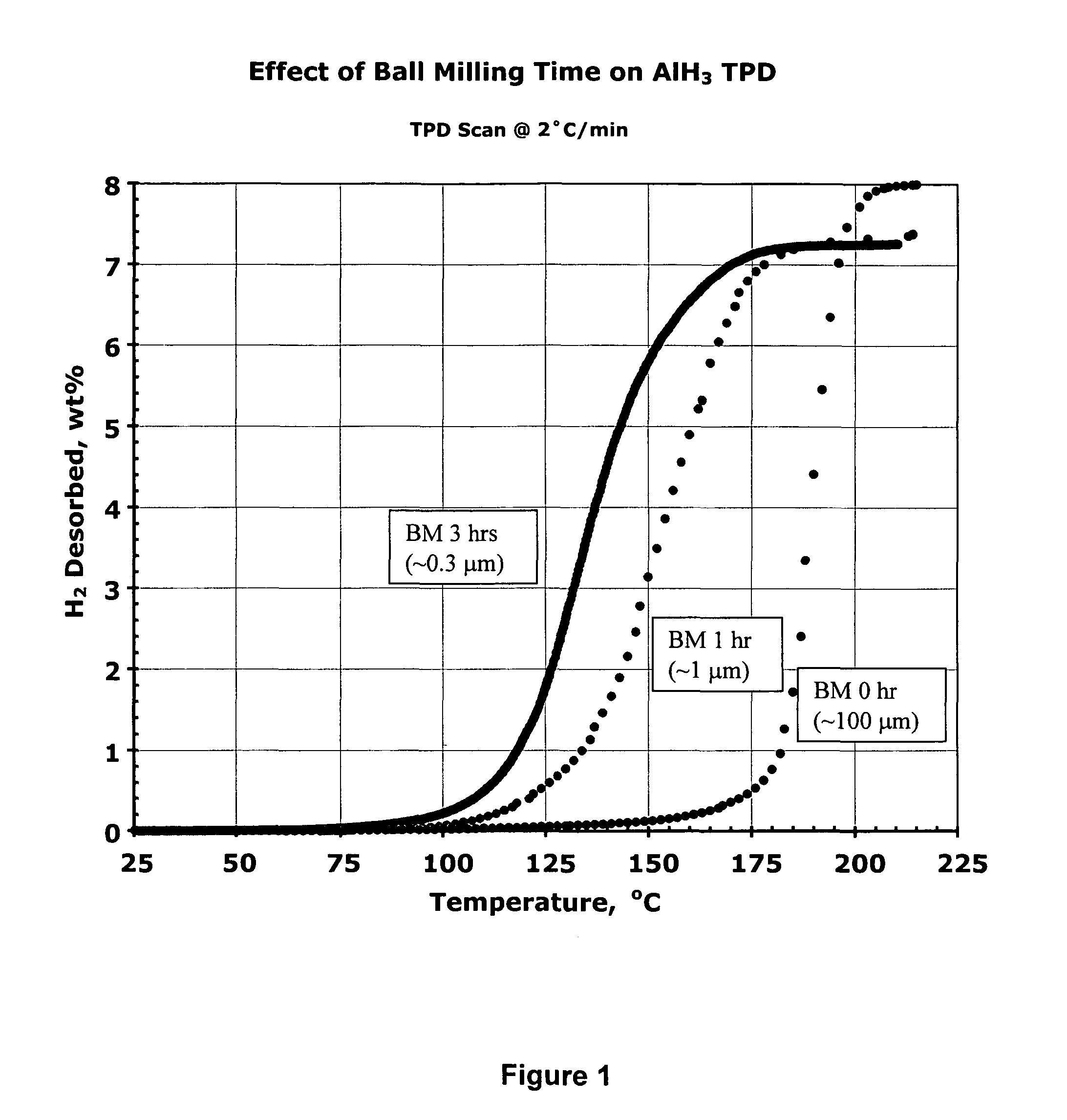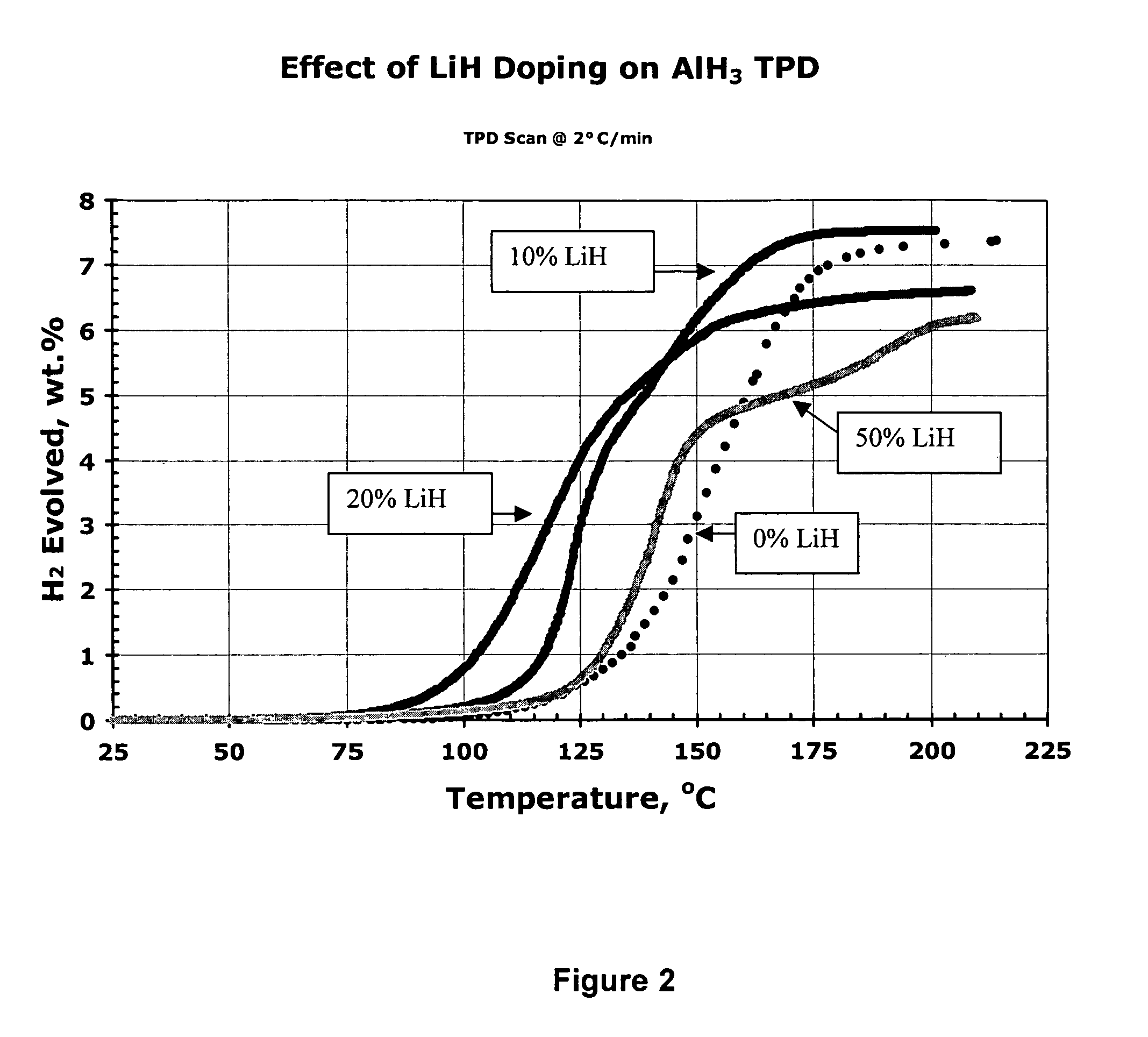Activated aluminum hydride hydrogen storage compositions and uses thereof
a hydrogen storage composition and aluminum hydride technology, applied in the field of activated aluminum hydride hydrogen storage compositions, can solve the problems of significant challenges in hydrogen as a fuel, energy insufficient, and volumetrically impractical hydrogen, and achieve the effect of improving desorption kinetics and high hydrogen storage capacities
- Summary
- Abstract
- Description
- Claims
- Application Information
AI Technical Summary
Benefits of technology
Problems solved by technology
Method used
Image
Examples
example 1
Procedures
[0155]In certain experiments, AlH3 samples were subjected to particle size reduction using a high energy planetary ball milling (Fritsch Pulverisette 6 at 200 RPM), using a 250 cm3 stainless steel vial, seven 15 mm diameter balls and 1.5 g samples (64:1 ball:powder ratio, by mass). In cases where a stimulant was introduced, it was mixed with the AlH3 sample in the planetary mill. The ball mill vial is equipped with a pressure transducer and thermometer, which allow instantaneous radio transmission of pressure and temperature data during milling. Samples were evaluated by two means: 1) Temperature programmed desorption (TPD), whereby the sample being tested is heated at a constant rate (2° C. / m) and the desorbed H2 collected in a previously evacuated calibrated volume. 2) The sample was decomposed at a constant temperature and the evolved hydrogen gas was collected in the calibrated volume. In both cases the final pressure in the calibrated volume was about 60 kPa. The samp...
example 2
Effect of Ball-Milling Time (and Particle Size) on Hydrogen Desorption from Aged α AlH3
[0156]In this experiment the sample was the a (trigonal / rhombohedral, R3c) phase of AlH3 made by Dow Chemical Co. in 1975 from LiAlH4 and AlCl3 by a wet (ether solvent) chemical process. It is the same batch used in the 1980 kinetic studies of Herley et al. See F. M. Brower, et al., J. Am. Chem. Soc., 98, 2450 (1976); A. E. Finholt, et al., J. Am. Chem. Soc., 62 (1947); P. J. Herley, et al., J. Phys. Chem., 85, 1874 (1981); P. J. Herley, et al., J. Solid State Chem., 35, 391 (1980).
[0157]The above form of AlH3 was found to be very stable and virtually solvent free. When it was received more than a quarter-century ago, it contained 8.3 wt % hydrogen, i.e., somewhat lower than the 10.1 wt % expected of pure AlH3. However, in an impressive testimony to its shelf life in air, the hydride still contains 8.0 wt % hydrogen. The sample consists of translucent, approximately 50-100 μm cuboidal particles. ...
example 3
Effect of Metal Hydride Stimulants on Hydrogen Generation from Aged α AlH3
[0159]In this experiment, aged α AlH3 was ball milled with 0, 10, 20 and 50 mole percent LiH stimulant (stimulant:aluminum hydride molecular ratio=0, 1:9, 1:4, and 1:1, respectively; molar amount of stimulant=0%, 10%, 20% and 50% of the combined molar amounts of aluminum hydride plus stimulant, respectively). FIG. 2 shows the effects of the addition of 10-50 mole percent LiH to AlH3 on the TPD curves. The desorption temperatures of the 10 and 20% LiH stimulated samples were reduced 40-50° C. compared to the ball milled metal hydride-free AlH3 sample. The 20% LiH sample even shows significant desorption starting below 100° C., albeit at an ultimate capacity of less than 7 wt %. This series of experimental results indicate that a ball milled mixture of AlH3 and LiH (at 10 to 20% mole percent) provides an excellent activated aluminum hydride hydrogen storage composition whereas a stoichiometric mixture of 50 mol...
PUM
| Property | Measurement | Unit |
|---|---|---|
| temperature | aaaaa | aaaaa |
| temperature | aaaaa | aaaaa |
| temperature | aaaaa | aaaaa |
Abstract
Description
Claims
Application Information
 Login to View More
Login to View More - R&D
- Intellectual Property
- Life Sciences
- Materials
- Tech Scout
- Unparalleled Data Quality
- Higher Quality Content
- 60% Fewer Hallucinations
Browse by: Latest US Patents, China's latest patents, Technical Efficacy Thesaurus, Application Domain, Technology Topic, Popular Technical Reports.
© 2025 PatSnap. All rights reserved.Legal|Privacy policy|Modern Slavery Act Transparency Statement|Sitemap|About US| Contact US: help@patsnap.com



